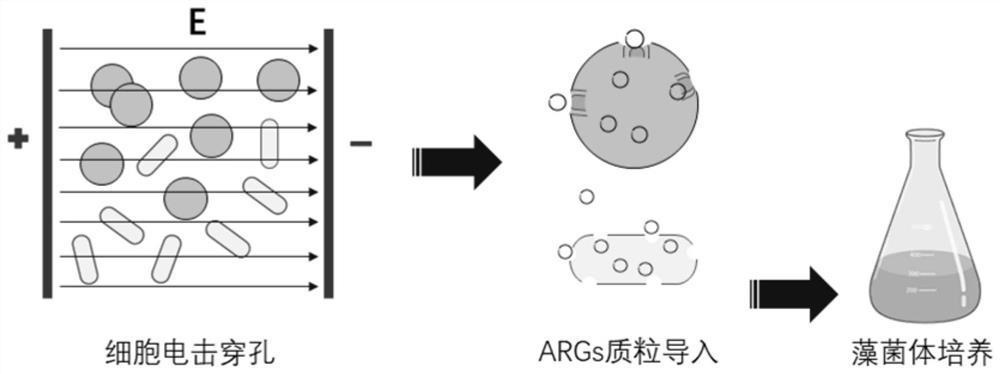Construction method of algae-bacteria symbiotic system for removing ARGs in water body
A technology of algae-bacteria symbiosis and construction method, which is applied in the direction of microorganism-based methods, biochemical equipment and methods, microorganisms, etc., to achieve the effect of quick and simple operation and low cost
- Summary
- Abstract
- Description
- Claims
- Application Information
AI Technical Summary
Problems solved by technology
Method used
Image
Examples
Embodiment 1
[0062] The concentration of algae cells was 1×10 8 cell / mL Chlorella vulgaris (purchased from the Freshwater Algae Species Bank of the Chinese Academy of Sciences, algae cell number: FACHB-8) 5mL, the concentration of the bacterial cells was 1×10 6 CFU / mL of Bacillus licheniformis (purchased from the Culture Collection Center of the Chinese Academy of Sciences, algae cell number: 1.7461) 5mL; centrifuge the two separately (8000g / min, 3min), discard the supernatant, and separate the two precipitates Inoculate in 150mL of sterilized BG11-LB medium and culture in a sterile room with constant temperature and constant light, set the temperature at 28°C, and set the light intensity at 120μmol / m 2 / s, wherein, BG11 medium, LB medium volume ratio is 1:1;
[0063] Add 0.011-65.2 μg of sul1, 0.010-58.6 μg of sul2, 0.010-58.6 μg of tetM, 0.011-64.2 μg of tetQ, and 0.010-58.6 μg of tetW to the artificial sewage to configure a plasmid concentration of 2.09× 10 5 -1.26×10 9 copies / mL of...
Embodiment 2
[0073] Reduction of Antibiotic Resistance Genes in Real River Wastewater Using Algae-bacteria Symbiosis System
[0074] 200-500mL of river sewage was collected, and the abundance of ARGs in the river water was found to be sul1: 1.5×10 5 copies / mL, sul2: 0.4×10 5 copies / mL, tetM: 1.2×10 5 copies / mL, tetQ: 2.35×10 5 copies / mL, tetW: 0.78×10 5 copies / mL,
[0075] Mix 150mL of BG11-LB medium inoculated with Chlorella and Bacillus licheniformis with the collected river water, and the initial dosage concentration of the algal symbiont is 2.5×10 6 cell / mL, the culture temperature is 28±2℃, the light-dark ratio is 12h:12h, and the light intensity is 120μmol / m 2 Cultivate under the / s culture condition for 5 days to obtain algae-bacteria symbiosis (algae-bacteria mixed solution);
[0076] After the electroporation treatment, the cells were continued to be cultured in the collected river sewage. The relative abundances of sul1, sul2, tetM, tetQ, and tetW in the water were: 0.3×10 ...
PUM
 Login to View More
Login to View More Abstract
Description
Claims
Application Information
 Login to View More
Login to View More - R&D
- Intellectual Property
- Life Sciences
- Materials
- Tech Scout
- Unparalleled Data Quality
- Higher Quality Content
- 60% Fewer Hallucinations
Browse by: Latest US Patents, China's latest patents, Technical Efficacy Thesaurus, Application Domain, Technology Topic, Popular Technical Reports.
© 2025 PatSnap. All rights reserved.Legal|Privacy policy|Modern Slavery Act Transparency Statement|Sitemap|About US| Contact US: help@patsnap.com



